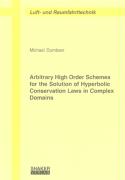- Start
- Arbitrary High Order Schemes for the Solution of Hyperbolic Conservation Laws in Complex Domains
Arbitrary High Order Schemes for the Solution of Hyperbolic Conservation Laws in Complex Domains
Angebote / Angebote:
In this work we develop new explicit Discontinuous Galerkin Finite Element schemes, called ADER Discontinuous Galerkin schemes in the following, of arbitrary order of accuracy in space and time to solve linear and nonlinear hyperbolic conservation laws that arise frequently in the description of physical phenomena. Some prominent examples of hyperbolic conservation laws which are treated here are the nonlinear Euler equations of gas dynamics, describing the behavior of compressible gases without viscosity and without heat conduction, or the linearized Euler equations, which are used to model the sound propagation in a medium.
The reason for developing very high order schemes is that they permit a good resolution of physical phenomena even on very coarse grids and that they exhibit only very little numerical dissipation, which is important when performing simulations in large domains for long times. Furthermore, grid refinement becomes much more efficient using higher order schemes since numerical errors decrease faster compared to the case when the same grid refinement is applied using a low order scheme. Our method relies essentially on the ADER approach developed originally by Toro et al. in the Finite Volume framework. The strategy consists in solving local generalized Riemann problems on the element interfaces where the initial conditions are piecewise polynomial instead of piecewise constant initial data that are typical of conventional Riemann problems. Toro et al. proposed to solve this kind of initial value problems by making the ansatz of a Taylor series in time at the interface and subsequently replacing time derivatives by space derivatives using repeatedly the governing partial differential equation. We present efficient algorithms for carrying out this procedure for linear and nonlinear hyperbolic systems. Since in the DG framework the numerical solution is allowed to be discontinuous at the element interfaces, the state and the space derivatives at the interface are computed by solving nonlinear and linearized homogeneous conventional Riemann problems, respectively. Finally, one obtains a high order accurate approximation of the numerical flux in time that can be integrated. The resulting scheme is explicit and uses only one single step to integrate the PDE from one time level to the other.
Libri-Titel folgt in ca. 2 Arbeitstagen

